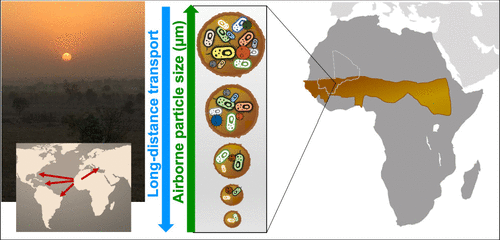当前位置:
X-MOL 学术
›
Environ. Sci. Technol.
›
论文详情
Our official English website, www.x-mol.net, welcomes your feedback! (Note: you will need to create a separate account there.)
The Microbiome of Size-Fractionated Airborne Particles from the Sahara Region
Environmental Science & Technology ( IF 11.4 ) Pub Date : 2021-01-21 , DOI: 10.1021/acs.est.0c06332 Rebecca A. Stern 1 , Nagissa Mahmoudi 2 , Caroline O. Buckee 3 , Amina T. Schartup 4, 5 , Petros Koutrakis 4 , Stephen T. Ferguson 4 , Jack M. Wolfson 4 , Steven C. Wofsy 6 , Bruce C. Daube 4 , Elsie M. Sunderland 1, 4
Environmental Science & Technology ( IF 11.4 ) Pub Date : 2021-01-21 , DOI: 10.1021/acs.est.0c06332 Rebecca A. Stern 1 , Nagissa Mahmoudi 2 , Caroline O. Buckee 3 , Amina T. Schartup 4, 5 , Petros Koutrakis 4 , Stephen T. Ferguson 4 , Jack M. Wolfson 4 , Steven C. Wofsy 6 , Bruce C. Daube 4 , Elsie M. Sunderland 1, 4
Affiliation

|
Diverse airborne microbes affect human health and biodiversity, and the Sahara region of West Africa is a globally important source region for atmospheric dust. We collected size-fractionated (>10, 10–2.5, 2.5–1.0, 1.0–0.5, and <0.5 μm) atmospheric particles in Mali, West Africa and conducted the first cultivation-independent study of airborne microbes in this region using 16S rRNA gene sequencing. Abundant and diverse microbes were detected in all particle size fractions at levels higher than those previously hypothesized for desert regions. Average daily abundance was 1.94 × 105 16S rRNA copies/m3. Daily patterns in abundance for particles <0.5 μm differed significantly from other size fractions likely because they form mainly in the atmosphere and have limited surface resuspension. Particles >10 μm contained the greatest fraction of daily abundance (51–62%) and had significantly greater diversity than smaller particles. Greater bacterial abundance of particles >2.5 μm that are bigger than the average bacterium suggests that most airborne bacteria are present as aggregates or attached to particles rather than as free-floating cells. Particles >10 μm have very short atmospheric lifetimes and thus tend to have more localized origins. We confirmed the presence of several potential pathogens using polymerase chain reaction that are candidates for viability and strain testing in future studies. These species were detected on all particle sizes tested, including particles <2.5 μm that are expected to undergo long-range transport. Overall, our results suggest that the composition and sources of airborne microbes can be better discriminated by collecting size-fractionated samples.
中文翻译:

撒哈拉沙漠地区大小受控制的悬浮微粒的微生物组
多种空气传播的微生物会影响人类健康和生物多样性,西非的撒哈拉沙漠地区是全球重要的大气尘埃来源地区。我们在西非马里收集了大小分级(> 10、10–2.5、2.5–1.0、1.0–0.5和<0.5μm)的大气颗粒,并使用16S rRNA对该区域的空气传播微生物进行了首次独立于培养的研究基因测序。在所有粒度级分中都检测到丰富多样的微生物,其水平高于先前为沙漠地区假设的水平。日平均丰度为1.94×10 5 16S rRNA复制/ m 3。<0.5μm粒子的每日丰度图与其他尺寸分数有显着差异,可能是因为它们主要在大气中形成,并且表面再悬浮作用有限。大于10μm的颗粒包含最大比例的日丰度(51–62%),并且比较小的颗粒具有更大的多样性。大于平均细菌的大于2.5μm的颗粒的细菌丰度更高,这表明大多数空气传播的细菌以聚集体形式存在或附着在颗粒上,而不是以自由漂浮的细胞形式存在。大于10μm的粒子的大气寿命非常短,因此倾向于具有更多的局部起源。我们使用聚合酶链反应确认了几种潜在病原体的存在,它们是未来研究中进行可行性和菌株测试的候选者。在所有测试的颗粒尺寸上都检测到了这些物质,包括<2.5μm的颗粒,这些颗粒有望进行远距离运输。总体而言,我们的结果表明,可以通过收集大小分级的样本更好地区分空气传播微生物的组成和来源。
更新日期:2021-02-02
中文翻译:

撒哈拉沙漠地区大小受控制的悬浮微粒的微生物组
多种空气传播的微生物会影响人类健康和生物多样性,西非的撒哈拉沙漠地区是全球重要的大气尘埃来源地区。我们在西非马里收集了大小分级(> 10、10–2.5、2.5–1.0、1.0–0.5和<0.5μm)的大气颗粒,并使用16S rRNA对该区域的空气传播微生物进行了首次独立于培养的研究基因测序。在所有粒度级分中都检测到丰富多样的微生物,其水平高于先前为沙漠地区假设的水平。日平均丰度为1.94×10 5 16S rRNA复制/ m 3。<0.5μm粒子的每日丰度图与其他尺寸分数有显着差异,可能是因为它们主要在大气中形成,并且表面再悬浮作用有限。大于10μm的颗粒包含最大比例的日丰度(51–62%),并且比较小的颗粒具有更大的多样性。大于平均细菌的大于2.5μm的颗粒的细菌丰度更高,这表明大多数空气传播的细菌以聚集体形式存在或附着在颗粒上,而不是以自由漂浮的细胞形式存在。大于10μm的粒子的大气寿命非常短,因此倾向于具有更多的局部起源。我们使用聚合酶链反应确认了几种潜在病原体的存在,它们是未来研究中进行可行性和菌株测试的候选者。在所有测试的颗粒尺寸上都检测到了这些物质,包括<2.5μm的颗粒,这些颗粒有望进行远距离运输。总体而言,我们的结果表明,可以通过收集大小分级的样本更好地区分空气传播微生物的组成和来源。


























 京公网安备 11010802027423号
京公网安备 11010802027423号